Table of Contents
- Comparing the Brains of Bilingual and Monolingual Individuals
- The Myth of the Critical Period Hypothesis (CPH) for Second Language Acquisition
- Additional Research on 2nd Language Learning and Changes in the Brain
- The Brain of Tonal Language Speakers
- Learning to Perceive and Produce New Sounds at Any Age
- More about Phonological interference, Neural Mapping, and Brain Traps
- There Must be a Willingness to Imitate and a Lack of Identity Issues
Learning a foreign language is an intricate task that involves numerous cognitive processes, such as memory, attention, and perception. The brain’s ability to adjust and reorganize itself in response to new information, experiences, or damage is known as neuroplasticity. This concept applies significantly to language learning, where structural and functional changes in the brain are seen.

Image Source: Future of Life Institute
1) Comparing the Brains of Bilingual and Monolingual Individuals
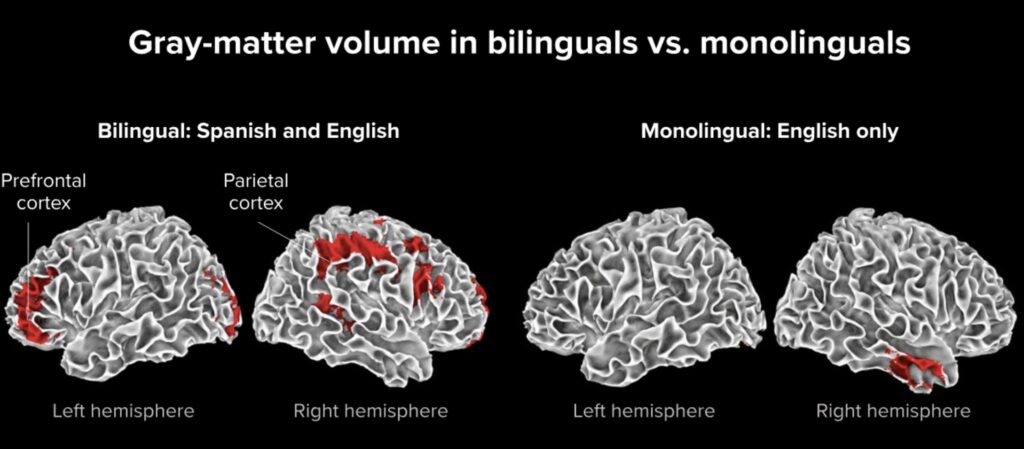
Grey Matter Density: Grey matter in the brain consists of neuronal cell bodies, dendrites, and synapses.
- Learning a new language can increase grey matter density in specific regions associated with language processing, like the left inferior parietal cortex. Bilingual individuals often have denser grey matter in these areas than monolingual individuals.
White Matter Integrity: White matter comprises nerve fibers (axons) that transmit signals between different brain regions.
- Studies involving diffusion tensor imaging (DTI) have shown that learning a new language can enhance white matter integrity, particularly in the corpus callosum and the tracts connecting language-related regions, which suggests increased network connectivity and efficiency.
Brain Function: Functional changes in the brain are another aspect of neurological change due to language acquisition.
- Functional MRI (fMRI) studies show that bilingual and multilingual individuals use their brains differently than monolingual individuals. For instance, the anterior cingulate cortex (ACC), a region involved in cognitive control and conflict resolution, is more active in bilinguals, reflecting an enhanced executive function.
Language Control Network: The brain’s language control network, which helps manage two or more languages, also changes with foreign language acquisition.
- This network includes regions like the anterior cingulate, dorsolateral prefrontal cortex, and the inferior parietal lobule. Bilinguals show different activation patterns and often have more robust connections between these areas.
Neuroprotection: Learning a foreign language can also contribute to cognitive reserve, a resilience to neurological damage.
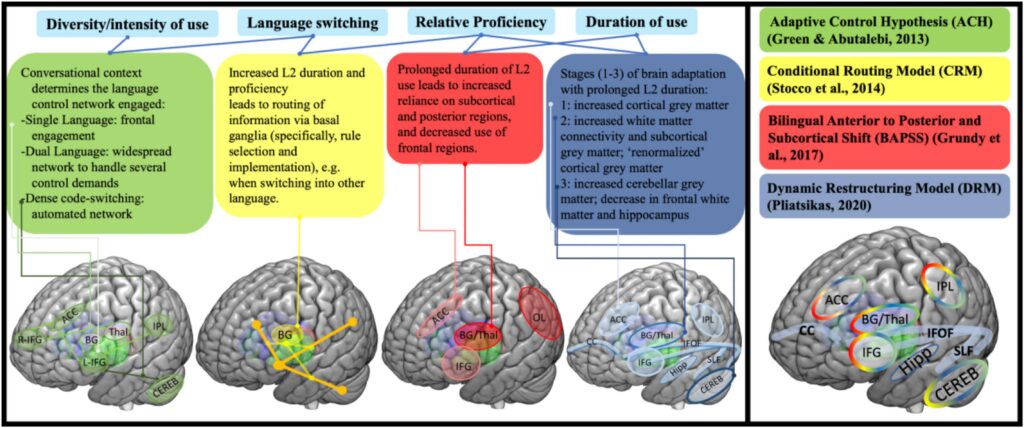
- Bilingual individuals often display delayed onset of dementia symptoms compared to monolingual counterparts, suggesting that the mental exercise of using multiple languages may provide neuroprotective benefits.
Neural Efficiency: The brain of bilingual individuals often shows signs of neural efficiency.
- That is, after reaching a certain proficiency level in a second language, the brain needs less effort to process the information in that language. This efficiency manifests in the form of reduced neural activity during language tasks in fMRI studies.
In conclusion, foreign language acquisition triggers a range of changes in the brain, indicating that our neural landscapes are not fixed but can be shaped and reshaped by our experiences and learning. This neuroplasticity is a testament to the brain’s remarkable capacity to adapt and evolve.

2) The Myth of the Critical Period Hypothesis (CPH) for Second Language Acquisition
The Critical Period Hypothesis (CPH) for Second Language Acquisition proposes that there is a biologically determined period in early childhood during which language learning is most effective. According to this hypothesis, there is an optimal age range, typically ending around puberty, within which individuals have the greatest potential to acquire a second language with native-like proficiency. Beyond this critical period, language acquisition becomes increasingly challenging and less successful.
While the CPH has been widely discussed and studied, there is no consensus among researchers regarding its validity. The first time I heard of it, I knew it had to be false from my own personal experience. At age 18 I only spoke English and Spanish. Since then, I have added more than 30 languages. Nevertheless, let’s discuss some of the arguments both supporting and challenging the CPH.
Supporters of the CPH argue that there is evidence suggesting a decline in language learning abilities with age. They point to the observation that children generally have an easier time acquiring language, both in terms of vocabulary and grammar, compared to adults. Supporters often cite the case of native-like pronunciation, which adults find more difficult to achieve, as evidence for the critical period.
However, humans are social beings, and nurturing relationships are a core need, particularly during the formative years of childhood. The language(s) of significant others, particularly caregivers, is usually acquired with apparent ease during this period. However, without motivation stemming from this interactional instinct, most attempts to teach a foreign language to a child will be of limited effectiveness. Indeed, adults often achieve lower proficiency levels than younger learners when a family moves to a place faced with a new language and culture. But this is due to contextual rather than biological factors. The researchers who believe in a critical period fall victim to three fallacies.
The first fallacy is the misinterpretation of observations of child and adult learners, which might suggest that children are fast and efficient at picking up second languages. Hard data clarifies children learn new languages slowly and effortfully—in fact, with less speed and more effort than adolescents or adults. The second fallacy is the misattribution of conclusions about language proficiency to facts about the brain. Finally, the common fallacy of reasoning from frequent failure to the impossibility of success. Most adult learners fail to engage in the task with sufficient motivation, commitment of time or energy, and support from the environment in which they find themselves to expect high levels of success.
On the other hand, critics of the CPH question the existence of a biologically determined cutoff point for language acquisition. They argue that various factors, such as motivation, exposure, and learning strategies, play significant roles in second language acquisition, irrespective of age. They point out that many adults become highly proficient in a second language, even if they may have an accent or minor grammatical errors.
Additionally, there are many cases of individuals (including myself for numerous languages) who have acquired an additional language beyond the suggested critical period and have achieved native-like proficiency. These cases challenge the strict timeline proposed by the CPH. Moreover, there is evidence that neuroplasticity, the brain’s ability to change and adapt, extends throughout life, suggesting that learning a second language is possible at any age.

It is important to note that the CPH was initially proposed based on research on first language acquisition and later applied to second language acquisition. However, the contexts and processes of acquiring a first language and learning a second language are not identical. First language acquisition occurs naturally and is typically acquired in a supportive environment, while second language acquisition involves conscious learning and is influenced by factors such as exposure and instruction.
In summary, the Myth of the Critical Period Hypothesis stems from the lack of consistent empirical evidence to support the existence of a rigid critical period for second language acquisition. While there may be certain advantages to learning a language at a younger age, the ability to acquire a second language with high proficiency extends well into adulthood. Factors such as motivation, exposure, and learning strategies play crucial roles in second language acquisition, regardless of age.
3) Additional Research on 2nd Language Learning and Changes in the Brain
3.1) The Brain of an Adult L2 learner is a Highly Dynamic Place
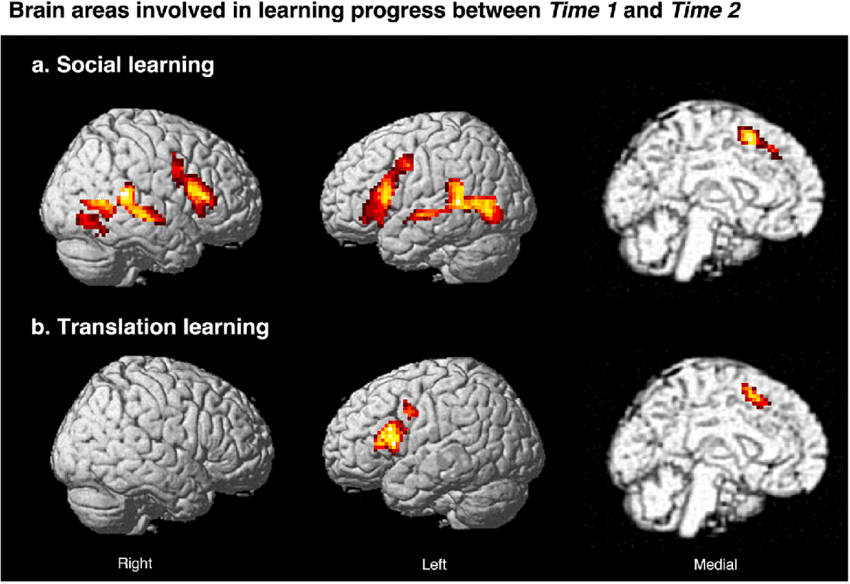
Osterhout et al. (2008) studied second language learning and changes in the brain. They investigate how modern brain-based methods can be used to discern some of the changes that occur during L2 learning (L2 indicating second language). According to the authors’ conclusions in the paper, their results suggest that the brain of an adult second-language learner is a highly dynamic place, even during the earliest stages of L2 learning.
Hesling et al. (2012) examined brain mechanisms underlying the processing of connected prosodic speech comprehension in moderately- and highly-proficient late second language learners. A main finding was that L1 (native language) and L2 (additional language)-connected prosodic speech stimuli were found to share the same neural network encompassing both the dorsal and ventral pathways in highly-proficient L2 subjects.
Furthermore, a positron emission tomography (PET) study of a subset of late bilinguals who managed to become extremely fluent in their L2 (second language) demonstrated that the cortical representations of L1 (first language) and L2 were indistinguishable from and similar to those of native speakers (Perani et al., 1998).
3.2) Ultimate Level of Proficiency is More Significant than Age of Acquisition

In comprehension tasks, the ultimate level of proficiency in L2, more than the age of acquisition, seems to predict whether the cortical representations of L1 and L2 match. This evidence clearly contradicts the crystallization hypothesis, which predicts that the later a second language is learned, the more the cortical representations of the second and the first languages will differ. It is not so much of an age-dependent phonomenon and more of a level-of-attainment phenomenon.
This is also confirmed by research carried out by Leonard et al. (2011) that clear demonstrates it is the lack of proficiency rather than secondary acquisition order that determines the recruitment of non-classical areas for word processing. In other words, the more fluent a person is in an additional language, the more word processing in the brain resembles that of the mother tongue.
Furthermore, the idea that imprinting of a language durng the very early stages of life is crucial to level of attainment in an additional language (what researchers such as Kuhl (2004) mistakenly conclude) is clearly false. A study was carried out using fMRI by Ventureyra et al. (2004) on Korean adults who had been adopted at a young age by French families. These adults became fluent in their second language and report no recollection of their native tongue.
Unlike young immigrant children, they had no connection to their mother tongue after moving to their new country. Their second language completely replaced their first language in neurological terms. The results of their study complement studies of recovery from large left hemisphere lesions by showing that this form of plasticity is not limited to exceptional situations of brain insult or intractable epilepsy, but that it also occurs in the normal brain.
Mechelli et al. (2004) also conclude that the degree of this structural reorganization in bilinguals is correlated with their second language performance. They note that their results are consistent with growing evidence that the human brain changes structurally in response to environmental demands. The size of and shape of areas of the brain respond to how they are used.
Maguire et al. (2000) demonstrated navigation-related structural change in the hippocampi of London taxi drivers. London taxi drivers take an exam demonstrating ability to navigate London’s complicated grid. It usually takes about three years of intensive training and twelve attempts to pass the exam. The hippocampi (one on each side of the brain) play a crucial role in memory. Drivers with forty years experience had more grey matter (which contains the neural-cell bodies) in the their posterior hippocampi (an area important for spatial memory) than did divers with just a few years experience. Once the cab drivers retired their hippocampi slowly shrunk back to more average sizes.
3.3) The Adult Human Brain is Capable of New Rapid Growth
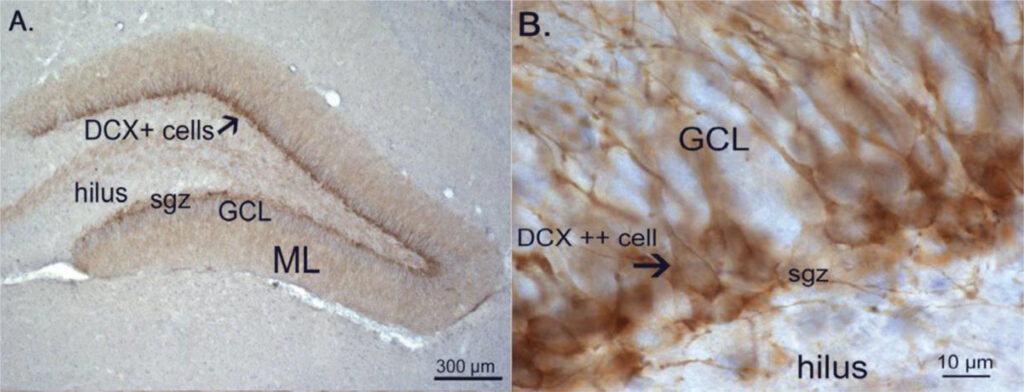
There is also evidence that restructuring or the creation of grey matter is not just a result of long-term language acquisition. Kwok et al. (2011) concluded that the adult human brain is capable of new rapid growth when exposed to stimuli similar to what babies experience as they are learning from their environment.
In their study colored cards (2 shades of green and 2 blue) were shown to 19 adult volunteers, each with nonsensical names. The participants were then asked to accept the new words as actual descriptors for the new colors and to memorize them so that they could reply with the correct color name at a later date and to match them when asked. The subjects practiced over a period of three days with five sessions each day with a total time of less than two hours.
After this experience all the subjects underwent fMRI scans and it was revealed that new grey matter had formed in the left hemisphere of their brains. This is the first experiment to demonstrate such rapid increase of grey matter. The inducement of this rapid increase is credited to the method they used that is claimed to simulate the rapid learning of word meanings by children. This is supported by the fact that the areas of the brain that grew new matter were parts of the brain known to process color and vision, and more importantly, perception.
It should be noted that neurological changes in early life could result from passive exposure, although attention and vigilance may facilitate neuroplastic change. Later in life attention paid to external stimuli and the meaning of the stimuli to the organism are key to neuroplastic change (Lilllard & Erisir, 2011). Thus, in the case of foreign language learning, as an adult, the amount of attention paid to input and the meaningfulness of input can account for significant differences in neurological change and subsequent performance in the target language.
4) The Brain of Tonal Language Speakers
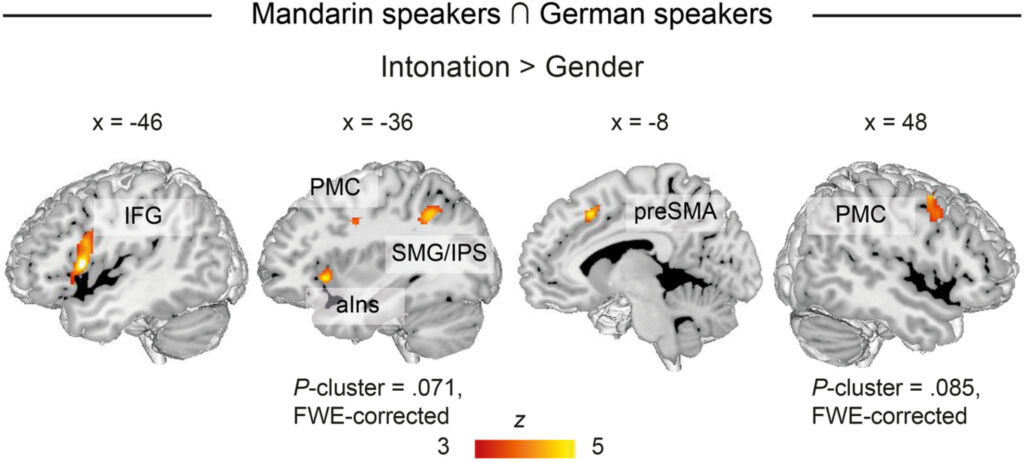
Crinon et al. (2009) identified regional structural differences in the brains of native speakers of a tonal language (Chinese) compared to non-tonal (European) language speakers. The investigation involved 31 native Chinese speakers, 7 English speakers who had learned Chinese in adulthood, and 21 European multilinguals who did not speak Chinese. The results identified two brain regions in the vicinity of the right anterior temporal lobe and the left insula where speakers of Chinese had significantly greater gray and white matter density compared with those who did not speak Chinese.
Importantly, the effects were found in both native Chinese speakers and European subjects who learned Chinese as a non-native language in adulthood, illustrating that they were language related effects and not ethnicity effects. On the basis of prior studies, they suggested that the locations of these grey and white matter changes in speakers of a tonal language were consistent with a role in linking the pitch of words to their meanings.
As seen in some of the studies discussed above, arguments for a critical period for learning additional languages based on the assumtion of age-related loss of brain plasticity are weak. Thomas (2012) points out that research with a range of species demonstrated that periods of heightened plasticity are a major phenomena in behavioral and brain development, but that periods of plasticity do not end so abruptly and are not as irreversible as first thought (Bolhuis, 1991; Michel and Tyler, 2005; Thomas and Johnson, 2008).
5) Learning to Perceive and Produce New Sounds at Any Age
Thomas (2012) proposes that a subtle loss of plasticity can be caused by a process of assimilation. He states, The formation of stable neurological representations in the brain of one set of information stops the system from perceiving new, different information because that information is simply assimilated via top-down processes into old information. If the system cannot perceive changes in the world, it cannot adapt to them. In this case, even though the system has not lost intrinsic plasticity, it will appear to have done so because it cannot detect the changes to which it should respond. (p. 6)
It is true that language learners may encounter difficulties in perceiving and producing sounds that are not present in their native language. This phenomenon, known as phonological interference, can be influenced by the individual’s native language phonetic inventory and the differences between the target language and their native language. In the case of Japanese speakers learning English, for example, the distinction between [R] and [L] can pose challenges due to the absence of a separate [L] sound in Japanese.
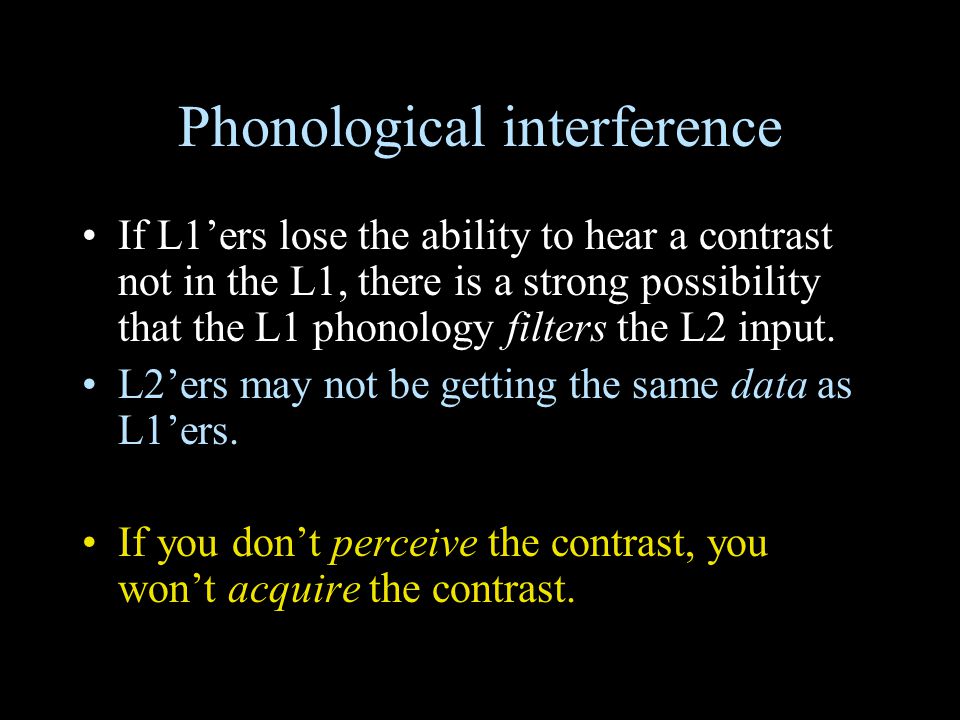
Phonological interference can also occur at the level of stress patterns, intonation, and rhythm, as different languages may have distinct patterns and rules governing these aspects. Learners may transfer the stress patterns or intonation patterns from their native language to the target language, leading to a noticeable accent or difficulty in conveying the intended meaning.
While the formation of stable neurological representations for certain sounds may influence language perception and production, it does not completely hinder the system from perceiving new information or adapting to changes. Language learning involves a dynamic interplay of various cognitive processes, and learners can develop strategies to overcome challenges. Through focused practice, explicit instruction, and exposure to the target language, learners can gradually develop their abilities to discriminate and produce unfamiliar sounds.
6) More about Phonological interference, Neural Mapping, and Brain Traps
There are many reasons why an accent may sound like a foreign accent such as correct pronunciation of individual words, the quality of phonetic entities, prosody (rhythm, stress, intonation), etc. In order to understand variations in accents and pronunciation among fellow speakers of your native language there are neural mappings that subsume all the related sounds that are not important in determining meaning.
This phenomenon of neural mapping subsuming other neural cortex geography is not restricted to language. Merzenich et al. (1996) have described what they call ‘brain traps,’ that occur when two brain maps, meant to be separate, merge.
One example they cite is that if monkey’s fingers were sewn together and so forced to move at the same time, the corresponding neural maps for the separate fingers in the brain would fuse, because their neurons fired together and hence wired together. This also occurs when a musician uses two fingers together frequently so when the musician subsequently tries to move only one finger both fingers move..

Since the basis of the problem is the absence of a differentiated auditory cortex for certain sounds, the solution is to seek to create differentiation by first introducing exaggerated differences that are noticeable. Thereafter, the sounds are normalized progressively as the subjects successfully differentiate the sounds. The process requires that the speakers always pay close attention throughout the exercises, something not normally done when listening to normal speech.
Merzenich concludes that it is possible to teach anyone to speak an accentless second language as an adult with proper training (Merzenich et al., 1996). Iverson (2005), of the UCL Center for Human Communication, echoed the same conclusion at the “Plasticity in Speech Perception 2005” workshop. He asserted that the our ability to hear and understand a second language becomes more and more difficult with age, but the adult brain can be retrained to pick up foreign sounds more easily again. It was also noted that this observation builds on an important new theory that the difficulties we have with learning languages in later life are not biological and that, given the right stimulus, the brain can be retrained.
7) There Must be a Willingness to Imitate and a Lack of Identity Issues

This same phenomenon can be observed between many languages. In the case of a Korean speaking Japanese, it is not a problem of not being able to distinguish between the sounds represented by が (ga) か (ka) in Japanese. Koreans also produce and distinguish these two sounds when speaking Korean. However, the phonetic rules of Korean never allow for the ‘ga’ sound to be the first sound of a word. On the other hand, Korean phonetics requires that the ‘ka’ sound mutate to ‘ga’ when it is preceded by another sound in a word (in other words when it is not the first syllable in a word).
Thus, when saying the Japanese word for university (大学–daigaku), Koreans can easily imitate the Japanese pronunciation. However, many Koreans do not pronounce the word for student (学生-gakusei), in which the second sound of in the word university comes first, like Japanese native speakers pronounce it. Instead they say what sounds like ‘kakusei’.
There are Koreans I know who have been in Japan for more than 20 or 30 years who still fail to pronounce the sound ‘ga’ like Japanese do when it is the first syllable of a word. Conversely, there are Koreans that have only been in Japan for a few years and imitate the Japanese pronunciation without difficulty.
When observing the behavior of both groups in interaction with Japanese, I can sense a different affective relationship between the individuals from these two groups and the Japanese. The ones who do imitate Japanese pronunciation seem to express a greater affinity towards Japanese people in their behavior. This is evident in their willingness to imitate Japanese patterns of non-verbal communication (for example body language) when interacting with Japanese. They appear to have a more developed sense of a ‘Japanese self’ coexisting with their identity as a Korean.
Their willingness to imitate appears to be accompanied by the development of the ability to notice the differences. When I bring this subject up with Koreans who do correctly imitate Japanese pronunciation they are invariably aware of how many other Koreans do not and confirm that they also sense a difference in affective stance of these Koreans towards the Japanese. As discussed above, recent neurological research indicates that attention, mindfulness, and noticing are important in the process of developing neurological change – learning.
For a detailed discussion of achieving a native-like accent please see my blog post – Is a Native-like Accent in a Foreign Language Achievable? (LINK)
References
Bolhuis, J. J. (1991). Mechanisms of avian imprinting: A review. Biological Reviews, 66: 303-345.
Hesling, I., Dilharreguy, B., Bordessoules, M. & Allard, M. (2012). The neural processing of second language comprehension modulated by the degree of proficiency: A listening connected speech fMRI study. Open Neuroimaging Journal, 6: 44-54.
Kuhl P. K. (2004). Early language acquisition: Cracking the speech code. Nature Reviews: Neuroscience, 5: 831-843.
Leonard M. K., Torres, C., Travis, K. E., Brown. T. T., Hagler, D. J. Jr., Dale, A. M., Elman, J. L. & Halgren, E. (2011) Language Proficiency Modulates the Recruitment of Non-Classical Language
Areas in Bilinguals. PLoS ONE, 6 (3): e18240. doi:10.1371/journal.pone.0018240
Maguire, E. A., Gadian, N. G. Johnsrude, I. S., Good, C. D., Ashburner, J., Frackowiak, R. S. & Fith, C. D. (2000). Navigation-related structural changes in the hippocampi of taxi drivers. Proceedings of the National Academy of Sciences of the United States of America, 97 (8): 4398-403.
Mechelli, A., Crinon, J. T., Noppeney, U., O’Doherty, J., Ashburner, J., Frackowiak, R. S. & Price, C. J. (2004). Neurolinguistics: Structure plasticity in the bilingual brain. Nature, 431: 757.
Merzenich, M. M. (2103). Soft Wired: How the New Science of Brain Plasticity Can Change Your Life. San Francisco: Parnassus Publishing.
Merzenich, M. M. & deCharms, R. C. (1996). Neural representations, experience, and change. In R. Llinas & P. S. Churchland (Eds.), The Mind-Brain Continuum: 61-81. Boston: MIT Press.
Merzenich, M. M., Nelson, R., Stryker, M., Cynader, M., Schoppmann, A. & Zook, J. (1984). Somatosensory cortical map changes following digit amputation in adult monkeys. Journal of Comparative Neurology, 224: 591-605.
Merzenich, M. M., Spengler, F., Byl, N., Wang, X. & Jenkins, W. (1996). Representational plasticity underlying learning: Contributions to the origins and expressions of neurobehavioral disabilities. In Ono, T., McNaughton, B. L., Molochnikoff, S., Rolls, E. T. & H. Nishijo (Eds.), Perception, memory and emotion: Frontiers in neuroscience: 45-61. Oxford: Elsevier Science.
Michel, G. F., & Tyler, A. N. (2005). Critical period: A history of the transition from questions of when, to what, to how. Developmental Psychobiology, 46: 156-162.
Osterhout, L., Poliakov, A., Inoue, K., McLaughlin, J., Valentine, G., Pitkanen, I., Frenck-Mestre, C. & Hirschensohn, J. (2008). Second language learning and changes in the brain. Neurolinguistics, 21 (6): 509-521.
Thomas, M. S. C. (2012). Brain plasticity and education. British Journal of Educational Psychology Monograph Series II: Part 8 Educational Neuroscience: 142-162.
Thomas, M. S. C. & Johnson, M. H. (2008). New advances in understanding sensitive periods in brain development. Current Directions in Psychological Science, 17 (1): 1-5.
Ventureyra, V. Pallier, C. & Yoo, Hi-Yon (2004). The loss of first language phonetic perception in adopted Koreans. Journal of Neurolinguistics, 17: 19-91.



Rachel
Learnt a lot from this, thanks Tim